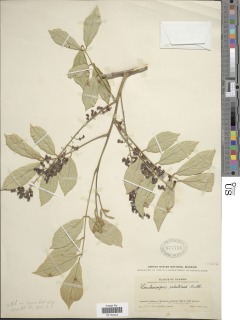

|
|
|
|
Family: Fabaceae
Chaperno, more...coto
|
Descripción: Árbol de 5 a 10 m de alto. Tronco con la corteza exterior negra. Ramitas terminales cubiertas de pelos ferruginosos. Hojas imparipinnadas y alternas. Folíolos de 3-12 x 3-6 cm, oblongos a obovados, con ápice acuminado, bordes enteros y base aguda o redondeada. Los folíolos presentan pelos de consistencia lanosa por el envés. Estípulas deciduas. Flores moradas. Frutos en legumbres aplanadas, de 3-7 cm de largo, verdes, tornándose amarillentos o marrón al madurar. Datos Ecológicos: La especie crece a bajas elevaciones, en bosques secos o húmedos. En Panamá se encuentra en las provincias de Coclé, Chiriquí, Herrera, Los Santos, Panamá y Veraguas. Común y fácil de observar en cercas a orillas de los caminos. Florece y fructifica de abril a julio. Especies Parecidas: A menudo se confunde con LK loncla Lonchocarpus heptaphyllus LK2 , pero en L. heptaphyllus los folíolos son de mayor tamaño y no presentan pelos de consistencia lanosa por el envés. Usos: La madera es empleada para postes de cercas y leña. Gallote Tree, to 18 m tall; trunk to 25 (30) cm dbh; branchlets strigillose. Leaves alternate, imparipinnate, to 30 cm long; stipules inconspicuous, caducous; petioles 2.5-10 cm long; petiolules ca 6 mm long; leaflets 5-9, +/- elliptic-obovate, mostly rounded-acuminate at apex, obtuse at base, 6-13 cm long, 3-7 cm wide, minutely puberulent appearing glabrous above, velutinous below, the trichomes not appressed, pilelike, the veins on the lower surface very conspicuous, anastomosing. Panicles of racemes axillary or terminal, 6-12 cm long; peduncles and all exposed parts of the flower densely pubescent, the trichomes short, appressed, whitish; flowers reddish-purple, ca 6 mm long, solitary or on secondary peduncles of 2 or 3 flowers; calyx flattened-cupular, drying black; petals conspicuously pubescent; standard somewhat spreading at anthesis; wings and keel erect. Legumes flattened, elliptic, at least 5-6 cm long, 1.5-2 cm wide, mostly rounded at apex, acute at base, apiculate, tan, the margins generally ca 1 mm wide, the pubescence dense, minute, golden, strigillose, soft to the touch and with a slight sheen; seed l, central. Croat 5121, 7772. Occasional, along the shore and in the forest. Flowers in February and March. The fruits mature from March through May. Most of the leaves fall around January, and the new leaves are immature or generally absent when flowering begins. The stems are generally not hollow. Central America to Colombia. In Panama, known from tropical moist forest in the Canal Zone, Chiriqui, Veraguas, and Panama and from premontane moist forest in the Canal Zone. |











